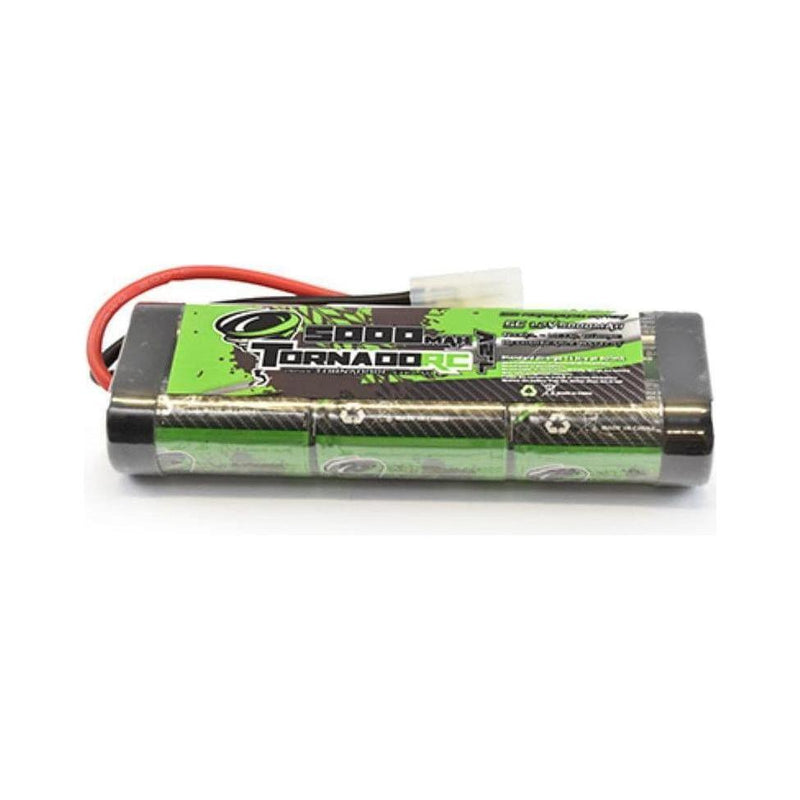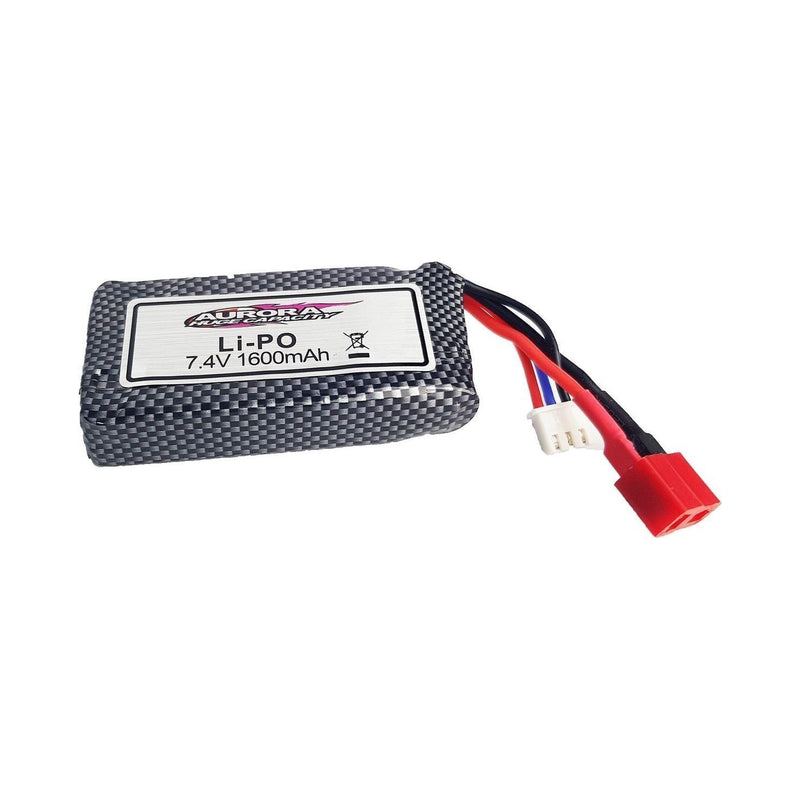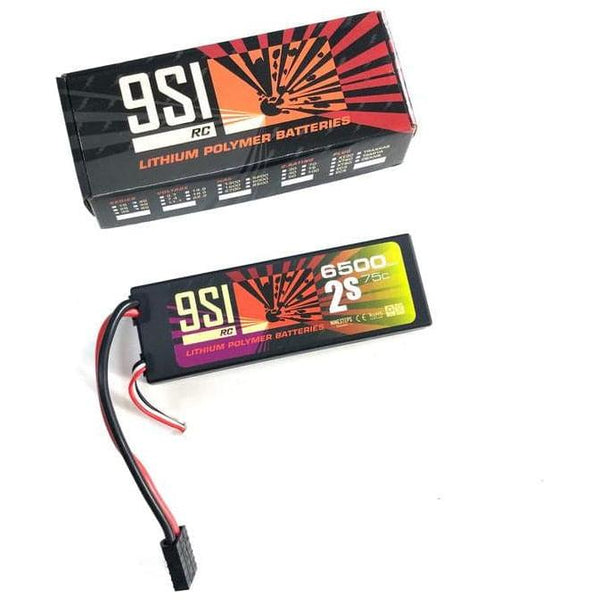RC Battery Maintenance: Extending Your Power Pack's Lifespan
We've all experienced that sinking feeling when our RC battery dies mid-run. Whether you're tearing up the track with your favourite Traxxas truck or perfecting your drift technique, a well-maintained battery makes the difference between consistent performance and frustrating failures.
At Hearns Hobbies, we see countless hobbyists struggle with premature battery death. The good news? Most battery failures are completely preventable with proper care. Today's RC batteries pack incredible power into compact packages, but they're not indestructible. Understanding how to maintain your LiPo and NiMH batteries can double or even triple their lifespan.
Think of your RC battery like the fuel tank in a real car – except this fuel tank has memory, preferences, and a definite expiration date if mistreated. Whether you're running high-discharge LiPos in your racing rig or dependable NiMH packs in your basher, the principles of good battery care remain surprisingly consistent.
This guide cuts through the technical jargon to deliver practical, actionable advice that'll keep your batteries performing at their peak. We'll explore storage techniques, charging best practices, and the warning signs that indicate your battery needs attention. More importantly, we'll help you avoid the expensive mistakes that send hobbyists back to the battery shelf far too often.
Table of Contents
Understanding RC Battery Types
Before diving into maintenance specifics, let's establish what we're working with. The RC world primarily uses three battery types, each with unique characteristics and care requirements. Understanding these differences forms the foundation of proper battery maintenance.
LiPo (Lithium Polymer) batteries dominate the performance scene. These powerhouses deliver incredible punch in lightweight packages, making them the go-to choice for serious racing applications. However, LiPos demand respect – they're sensitive to overcharging, physical damage, and temperature extremes. A well-maintained LiPo delivers consistent voltage throughout its discharge cycle, but a neglected one becomes a safety hazard.
NiMH (Nickel-Metal Hydride) batteries offer forgiveness where LiPos demand precision. These workhorses suit beginners and bashers perfectly, tolerating charging mistakes and physical abuse better than their lithium cousins. While they can't match LiPo performance, NiMH batteries provide reliable power for casual runners who prioritize durability over peak performance.
LiFe (Lithium Iron Phosphate) batteries occupy the middle ground, combining some of LiPo's performance with enhanced safety and longevity. Though less common in RC applications, LiFe batteries excel in transmitter applications and situations where stability matters more than maximum power output. Their voltage characteristics differ significantly from other types, requiring compatible chargers and speed controllers.

Charging Fundamentals and Safety
Proper charging habits determine whether your batteries last months or years. Each chemistry requires specific charging protocols, and mixing them up ranges from inefficient to dangerous. Modern smart chargers handle most of the complexity, but understanding the basics prevents costly mistakes.
LiPo charging operates on the constant current/constant voltage principle. Your charger pumps current until reaching the cell voltage limit (4.2V per cell), then maintains that voltage while current naturally tapers off. Never exceed 1C charging rates unless your battery specifically supports faster charging – patience here literally pays dividends in battery longevity. Balance charging ensures each cell reaches full capacity, preventing the weakest cell from limiting overall performance.
NiMH batteries prefer the delta-peak detection method, where chargers monitor voltage changes to determine full charge. Unlike LiPos, NiMH cells can handle higher charge rates – typically 2C to 5C – without significant degradation. However, they generate heat during charging, making temperature monitoring crucial. Some racers use cooling fans to maintain optimal charging temperatures during quick pit stops.
Storage charging represents one of the most overlooked aspects of battery care. LiPos stored at full charge degrade rapidly, while those stored empty risk dropping below recoverable voltages. The sweet spot sits around 3.8V per cell – roughly 50-60% charge. Quality chargers include storage modes that automatically bring batteries to this optimal level. For NiMH packs, store them with a slight charge and cycle them monthly to prevent crystallization.
Safety First
Always charge batteries in a fireproof container or LiPo bag, away from flammable materials. Never leave charging batteries unattended, especially LiPos. If a battery shows any swelling, unusual heat, or damage, discontinue use immediately. Your safety trumps any battery's value.
Storage Best Practices
How you store your batteries between runs impacts their health as much as how you use them. Temperature, charge state, and physical protection all play crucial roles in maintaining battery performance during downtime. Australian conditions pose unique challenges – our hot summers and varying humidity levels demand extra attention to storage protocols.
Temperature control sits at the heart of good storage practice. Batteries prefer cool, dry environments around 15-25°C. Avoid garages that turn into ovens during summer or experience wide temperature swings. A climate-controlled cupboard inside your home provides ideal conditions. For those with extensive collections, consider a dedicated storage solution that protects batteries from physical damage while maintaining stable temperatures.
Physical protection prevents the punctures and compression that turn batteries into hazards. Hard cases protect individual batteries during transport, while storage boxes keep your collection organized and safe. Never stack heavy items on batteries or store them loose where they might get crushed. The few dollars spent on proper storage containers pale compared to replacing damaged batteries – or worse, dealing with a battery fire.
Long-term storage requires special consideration. Batteries naturally self-discharge over time, with rates varying by chemistry and temperature. Check stored LiPos monthly, topping them up to storage voltage if they've dropped below 3.7V per cell. NiMH batteries benefit from periodic cycling – every 2-3 months, run a full charge-discharge cycle to maintain capacity. Mark storage dates on batteries to track maintenance schedules easily.
Storage Quick Reference
| Battery Type | Storage Voltage | Check Interval |
|---|---|---|
| LiPo | 3.8V per cell | Monthly |
| NiMH | 30-40% charge | Bi-monthly |
| LiFe | 3.3V per cell | Monthly |
Performance Optimization Tips
Maintaining peak battery performance goes beyond basic care – it requires understanding how usage patterns affect battery health. Small adjustments to your running habits can significantly extend battery life while maintaining the performance you expect from your RC vehicles.
Temperature management during use proves just as critical as storage temperature control. Batteries generate heat during discharge, with high-current draws creating the most stress. Installing cooling systems in speed run cars or limiting full-throttle bursts in bashers prevents overheating. Some racers use temperature stickers that change colour when batteries exceed safe temperatures – a simple solution that prevents expensive damage.
Discharge depth significantly impacts battery lifespan. While modern LiPos can safely discharge to 3.0V per cell, stopping at 3.3V or 3.5V dramatically extends cycle life. Program your ESC's low voltage cutoff conservatively – the minimal performance loss in the last 10% of capacity isn't worth the wear on your batteries. For competition use where every second counts, save deep discharges for race day only.
Matching batteries to applications optimizes both performance and longevity. That high-discharge 100C pack might seem appealing for your trail crawler, but it's overkill that adds weight and cost without benefit. Conversely, pushing a 25C battery in a high-powered speed run car stresses it beyond design limits. Calculate your actual current draw and select batteries with comfortable headroom – typically 20-30% above peak demands.

Troubleshooting Common Issues
Even with perfect care, batteries occasionally develop issues. Recognizing problems early often means the difference between a simple fix and a dead battery. Understanding common symptoms helps diagnose issues before they become critical failures that sideline your favourite RC.
Cell imbalance plagues multi-cell packs, particularly LiPos pushed hard without regular balance charging. Symptoms include reduced runtime, inconsistent performance, and chargers refusing to complete cycles. Check individual cell voltages with a meter – differences exceeding 0.1V indicate imbalance. While balance chargers can correct minor imbalances, severe cases might require professional cell matching or battery retirement.
Capacity loss creeps up gradually, making it easy to miss until performance notably suffers. If your 5000mAh battery only delivers 3500mAh, age and wear have taken their toll. Chargers with discharge functions can measure actual capacity, helping track degradation over time. While some capacity loss is inevitable, proper care minimizes the rate of decline.
Physical damage demands immediate attention. Puffed LiPos indicate internal damage – gas generation from decomposing electrolyte. Never puncture or compress puffed cells; the escaping gases are toxic and flammable. Dented or crushed areas compromise the internal structure, creating hot spots during use. When in doubt, retire questionable batteries – no run is worth risking your safety or equipment.
Connection issues often masquerade as battery problems. Corroded or worn connectors increase resistance, generating heat and reducing performance. Regular inspection and cleaning of battery connectors prevents these issues. Consider upgrading to higher-quality connectors if you frequently connect and disconnect batteries – the improved conductivity and durability justify the modest cost.
Warning Signs
Discontinue battery use immediately if you notice: unusual odours, excessive heat during normal use, visible swelling or deformation, liquid leaking from cells, or dramatic capacity loss. These symptoms indicate potentially dangerous failures requiring safe disposal.
Seasonal Maintenance Considerations
Australian seasons bring unique challenges to battery maintenance. Our scorching summers and variable winters demand seasonal adjustments to keep batteries healthy year-round. Understanding these seasonal impacts helps you adapt maintenance routines for optimal battery life regardless of weather conditions.
Summer heat poses the greatest threat to battery longevity. Ambient temperatures above 35°C accelerate chemical degradation in all battery types. During extreme heat, consider running sessions during cooler morning or evening hours. Transport batteries in insulated containers, never leaving them in hot cars where temperatures can exceed 60°C. Some dedicated racers use cooler bags with ice packs for transport, though avoid direct contact between batteries and ice.
Winter brings different challenges, particularly for those in Australia's cooler regions. Cold batteries deliver reduced capacity and voltage, affecting performance noticeably below 10°C. Warm batteries to room temperature before use – never charge a frozen battery. LiPos suffer permanent damage if charged below 0°C, while NiMH batteries simply won't accept charge properly. Store batteries indoors during winter months, bringing them out only for use.
Humidity variations throughout the year affect storage requirements. High humidity promotes corrosion on connectors and can penetrate damaged battery wrapping. Silica gel packets in storage containers combat moisture, requiring replacement when saturated. During humid periods, inspect batteries more frequently for signs of corrosion or moisture ingress. Clean connectors with appropriate contact cleaners to maintain good electrical connections.
Seasonal usage patterns also impact maintenance schedules. Many hobbyists reduce activity during extreme weather, leading to extended storage periods. Adjust your maintenance routine accordingly – batteries sitting unused for months need different care than those in weekly use. Set calendar reminders for storage charge checks and periodic cycling of inactive batteries.
Summer Checklist
- • Run during cooler hours
- • Use insulated transport
- • Increase cooling periods
- • Monitor temperatures closely
- • Store in coolest room
Winter Checklist
- • Warm before use
- • Never charge if frozen
- • Indoor storage essential
- • Expect reduced capacity
- • Cycle stored batteries
Essential Safety Equipment
Battery safety equipment represents cheap insurance against expensive disasters. While modern batteries prove remarkably safe when handled properly, accidents happen. Having the right safety gear on hand transforms potential catastrophes into minor inconveniences. Every RC enthusiast should invest in basic safety equipment before their battery collection grows.
LiPo charging bags top the essential safety equipment list. These fire-resistant bags contain battery failures, preventing spread to surrounding areas. While they won't completely contain a major battery fire, they buy crucial time to respond safely. Use them religiously when charging, and consider them for storage of older or questionable batteries. The peace of mind alone justifies the modest investment.
Battery voltage checkers and alarms serve dual purposes – performance monitoring and safety assurance. Simple voltage checkers let you verify cell balance and overall health quickly. Low voltage alarms for flight packs prevent over-discharge, while temperature monitoring devices warn of overheating during use. These tools cost less than a single battery but prevent damage to entire collections.
Fire suppression equipment belongs near any charging station. A Class D fire extinguisher handles lithium fires effectively, though even a bucket of sand works in emergencies. Never use water on battery fires – it can spread flaming electrolyte and generate toxic gases. Position extinguishers where they're accessible without reaching over burning batteries. Regular fire drills might seem excessive, but knowing exactly what to do in an emergency prevents panic responses.
First aid supplies specific to battery accidents deserve consideration. Chemical burns from leaking electrolyte require immediate flushing with water and proper wound care. Keep eye wash stations near charging areas, along with basic burn treatment supplies. While serious injuries remain rare with proper handling, preparation prevents minor accidents from becoming major injuries.

Maximizing Battery Lifespan
Combining all these maintenance practices creates a comprehensive approach to battery longevity. Small habits compound over time, turning batteries that might last six months into reliable performers for years. The most successful RC enthusiasts treat battery maintenance as part of their regular routine, not an afterthought when problems arise.
Rotation strategies prevent any single battery from bearing all the wear. Number your batteries and use them in sequence, ensuring even usage across your collection. This approach proves particularly valuable for racers with multiple identical packs – rotating prevents one becoming the "practice battery" that gets abused while others stay pristine for race day. Track usage with simple logs or smartphone apps designed for RC inventory management.
Breaking in new batteries properly sets them up for long, productive lives. Despite manufacturer claims of "no break-in required," gentle initial cycles benefit all battery types. For LiPos, perform several cycles at low discharge rates before pushing them hard. NiMH batteries respond well to traditional break-in procedures – multiple charge-discharge cycles at moderate rates. This process identifies weak cells early while conditioning the pack for optimal performance.
Regular maintenance schedules prevent small issues from becoming major problems. Monthly visual inspections catch physical damage early. Quarterly capacity checks track degradation rates. Annual connector replacements on frequently used batteries prevent resistance buildup. These simple tasks take minutes but add months or years to battery life. Consider setting smartphone reminders or integrating battery maintenance into your regular RC maintenance routine.
Documentation might seem excessive for hobby batteries, but tracking performance over time reveals patterns. Note purchase dates, initial capacities, and any issues encountered. This data helps identify which brands and models provide the best longevity for your use cases. When batteries eventually fail, you'll know whether you got good value and can make informed purchasing decisions for replacements from our battery selection.
Maintenance Log Template
Battery ID: _______ Purchase Date: _______
Initial Capacity: _______ Chemistry: _______
Usage Notes: _______________________
Retirement Date: _______ Reason: _______
Frequently Asked Questions
How often should I balance charge my LiPo batteries?
Balance charge every 5-10 cycles for batteries in regular use, or monthly for stored batteries. Racing applications might require balance charging before each event for optimal performance. Watch for increasing cell voltage differences – if cells drift more than 0.05V apart during use, increase balance charging frequency. Modern smart chargers make balance charging convenient enough to do regularly without hassle.
Can I revive a battery that won't charge?
Sometimes, but proceed with extreme caution. NiMH batteries often recover with slow trickle charging or cycling. LiPos below 3.0V per cell require special recovery procedures that carry fire risks – many experts recommend disposal instead. Never attempt to force-charge batteries showing physical damage. If attempting recovery, use appropriate safety equipment and never leave the battery unattended. Often, the cost and risk of revival exceed simply purchasing a replacement.
What's the real-world lifespan of RC batteries?
With proper care, expect 150-300 cycles from LiPos, 300-500 cycles from NiMH batteries, and 500-1000 cycles from LiFe cells. Real-world lifespan varies dramatically based on usage patterns, discharge depths, and maintenance quality. Competition use shortens lifespan compared to casual bashing. Batteries used gently and maintained properly often exceed these estimates, while abused batteries might fail in dozens of cycles.
Should I discharge batteries before storage?
For LiPos, absolutely yes – store at 3.8V per cell using your charger's storage mode. NiMH batteries prefer partial charge for storage, around 30-40% capacity. Never store batteries fully discharged as self-discharge might drop them below recoverable voltages. LiFe batteries tolerate various storage voltages well but still benefit from storage at nominal voltage. Set calendar reminders to check stored batteries monthly, especially during temperature extremes.
Final Thoughts
Battery maintenance might not be the most exciting aspect of RC hobbies, but it's certainly one of the most important. We've covered everything from basic chemistry understanding to advanced optimization techniques, but the core message remains simple: respect your batteries, and they'll reward you with reliable performance.
The practices we've outlined aren't just theoretical – they're proven techniques we see work every day at Hearns Hobbies. Whether you're powering a casual entry-level basher or a competition-grade race machine, these maintenance habits will extend battery life and improve your RC experience.
Remember, good battery care is about consistency, not perfection. Start with the basics – proper charging, appropriate storage, and regular inspections. As these become habits, add more advanced techniques. Your future self will thank you when those batteries are still going strong years from now, while others are shopping for expensive replacements.
 is here! Shop now, pay later in 4 easy installments
is here! Shop now, pay later in 4 easy installments

